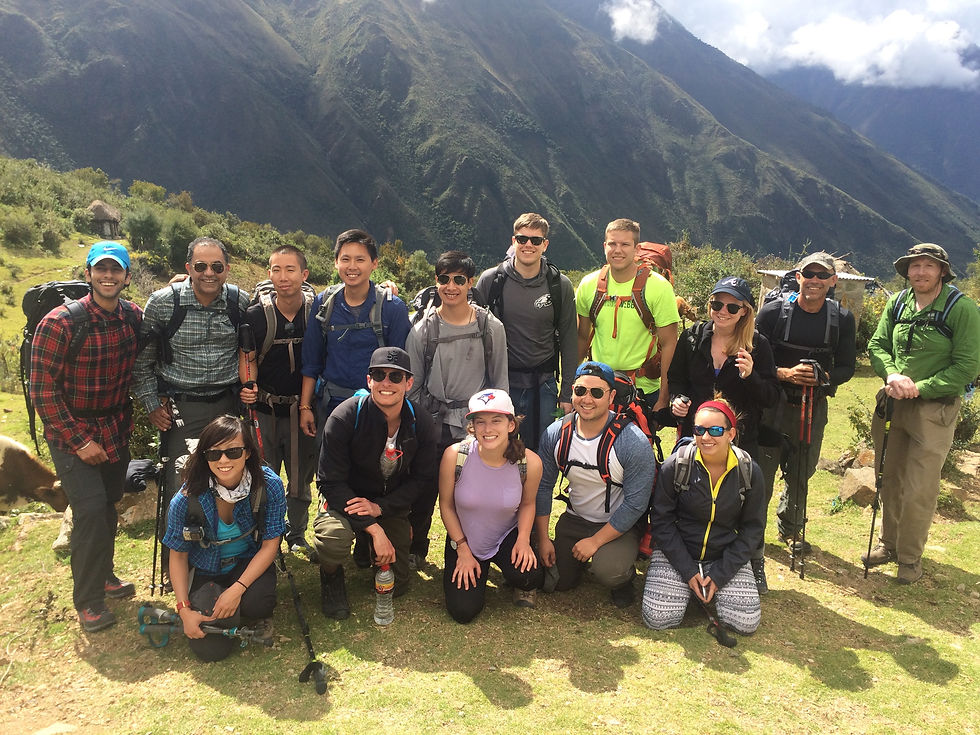Guide to a Successful Salkantay Trek
- Kyle and Megan
- Mar 20, 2017
- 3 min read


Peru offers numerous treks to get to one of the seven wonders of the world, Machu Picchu. The Inca Trail is the most popular trail, however this trial becomes booked very quickly. The trail only allows a certain number of travelers per day to prevent wear-and-tear on the trail. Tickets for the trail go on sale January 1st for the year. By mid-January, all of the May tickets were sold out. We were disappointed until we discovered the Salkantay Trial (pronounced "sal-can-tie"). Salkantay means "savage" in Quechua, the local language of the mountain areas of Peru, and this trail is no joke. The Salkantay trail offers a journey through every terrain and unforgettable sites, but the trail is also much longer, harder, and higher than the Inca Trail. We took this as a challenge, and it lived up to the expectation.
Who we Recommend:
In Cusco, numerous tour companies offer the Salkantay Tours. If you want to be truly adventurous, you can choose to do the trail yourself without a tour company. Every tour company takes you along the same Salkantay Trail, but your experience can differ based on the tour company. We chose Llama Path, and we highly recommend them for anyone travelling to the area. While they are not the cheapest option, I believe they are worth every penny. We traveled in a group of 15 people, and two guides were assigned to our group. They both spoke fluent English and were very knowledgeable about the history of the trail and the native species found today. The food provided was delicious, and the porters carried everything we needed and more.

About the Trail:

This is truly a once-in-a-lifetime hike. Throughout the five day hike, you experience multiple biomes from arctic tundra to tropical rain forests and everything in-between. The 37 mile hike is spread across four days with the fifth day of your trek spent exploring Machu Picchu all day. The second day is by far the most challenging. On this day, not only do you summit the highest point on the trek (15,000 ft) but also walk the longest distance of any day on your trip. The tour company provides "ambulance horses" if anyone feels they are unable to keep up on this brutal day. We walked over 50 miles in 5 days with the addition of walking around Machu Picchu on the fifth day as well as hiking to and from a glacial lake on day one. The trip is doable even for a novice hiker, but it is best to fully understand what you are signing up for. We recommend breaking in your hiking boots and getting accustomed to long hikes prior to your trip. To train, we would go on 10+ mile hikes through portions of the Appalachian Trail. Although these hikes are at a lower elevation and less steep than some days on your trek, we felt prepared to endure the challenging trek ahead of us. Below is a chart demonstrating the elevation changes and distances walked during your Salkantay Trek.

Essential Packing List:
The tour company provided the essentials (sleeping bag, tent, food, water), but you will be responsible for bringing everything else. Also, the company provided us with a medium duffel to fit our personal belongings, and everything else you must carry. We recommend staying at a hotel that is willing to hold your large duffel/backpack that was used to get the luggage down to Peru, but any additional luggage will not fit in your tour provided bag. Below are the essential things to pack for your trip:
Gear
Flashlight/head lamp
Day pack. This should be something small to hold your water bottle, camera, and any extra layers you might shed throughout the day.
Water bottle or CamelBak
Check with the tour company regarding what gear is provided and what needs to be brought. For example, Llama Path provided tents, sleeping bags, mattress pads, and walking sticks (for an additional fee)
Clothing
Rain jacket
Warm jacket
Warm hat
Gloves
Shirts
Pants/leggings
Hiking socks
Hiking boots
Sandals (to give your feet a rest at night)
Other
Passport
Cash (for tips, food, small purchases)
Sunscreen
Bugspray
Toilet paper (not provided in all bathrooms)
Soap/shampoo/conditioner (for showers in hotel before/after your trek)
Wet wipes (no showers during hike)
Toothbrush/toothpaste
Hand sanitizer
Snacks
Ibuprofen
Moleskin
Band aids
Altitude medicine. We used Diamox. I believe it significantly helped me adjust to the altitude, but Kyle did not use it at all and felt fine. Consult with a doctor before your trip as altitude affects everybody differently.









Comments